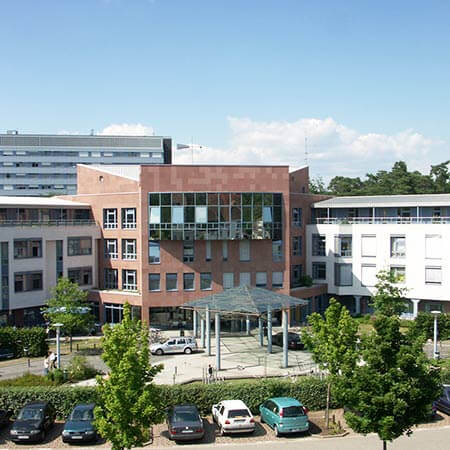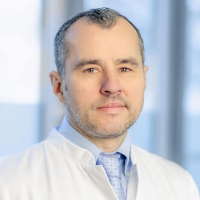Liver Metastases Treatment by Embolization (coiling)
Treatment prices are regulated by national law of the corresponding countries, but can also include additional hospital coefficients. In order to receive the individual cost calculation, please send us the request and medical records.

Department of Interventional Neuroradiology
The Department of Interventional Neuroradiology offers the full range of services in the areas of its specialization. The medical facility provides imaging diagnostics and low-traumatic image-guided interventional treatment of nervous system diseases. The department's specialists have rich experience and exceptional professional skills in the field of interventional procedures for acute and chronic vascular diseases, such as ischemic strokes, brain hemorrhages, cerebral artery stenosis, brain aneurysms, and vascular malformations. The department's neuroradiologists cooperate closely with neurologists and neurosurgeons so that each patient receives an optimal treatment regimen based on the expert opinions of the specialists. The department's medical team has state-of-the-art computed tomography (CT), magnetic resonance imaging (MRI), and MR angiography systems that are actively used for diagnosing patients and therapeutic procedures. Medical care is provided in compliance with current clinical protocols. The department also offers many outpatient medical services, which is an advantage for many patients.




Department of Interventional Radiology
The Department of Interventional Radiology offers the full range of modern diagnostic procedures using ionizing radiation, image-guided tissue sampling (biopsy), and minimally invasive therapeutic procedures. Patients may be seen on an inpatient or outpatient basis. To achieve optimal results, the department works closely with specialists in radiation therapy, oncology, neurology, neurosurgery and neuro-oncology, as well as urology, orthopedics, pain management, and palliative care. This collaboration helps ensure an accurate diagnosis and the most effective treatment.





Department of Diagnostic and Interventional Radiology, Nuclear Medicine
The Department of Diagnostic and Interventional Radiology, Nuclear Medicine offers the full range of diagnostic and therapeutic procedures in the areas of its specialization. The department has high-tech equipment for all types of modern imaging tests, image-guided therapeutic procedures, as well as radioisotope examinations and treatment of thyroid diseases using radioiodine therapy. The patients are provided with both inpatient and outpatient medical care. However, hospitalization is usually required only in the case of complex therapeutic interventions. The patients' health is in the good hands of the highly qualified doctors. The specialists regularly undergo advanced training courses, attend medical congresses and symposia, where they find out about innovations in the area of their specialization and share their experience with colleagues. To provide maximum safety for patients, the department strictly adheres to radiation protection standards.




Depending on the origin of the tumor, primary and metastatic liver cancer is distinguished. Secondary cancer (liver metastases) is much more common. In European countries and the United States, it occurs on average 20 times more often compared to primary liver cancer. Liver metastases require a specific therapy.
Content
- Overview
- Symptoms
- Diagnostics
- Treatment
- Where can I undergo cancer treatment by embolization (coiling) abroad?
- The cost of treatment by embolization (coiling)
- How can I undergo cancer treatment by embolization (coiling) abroad?
Overview
Liver cancer can be primary or secondary. The primary tumor occurs spontaneously, against the background of chronic inflammatory diseases, like cirrhosis. A secondary tumor or liver metastases usually appear due to spreading of cancer cells from a tumor of a different location.
Liver metastases often arise due to the peculiarities of blood flow in the organ. The liver performs many important functions in the body. All the blood passes through it many times daily. About 1.5 liters of blood flow through the liver vessels during one minute, which is about 30% of the total blood volume in the body. To filter and purify the blood, it must be slowed down and redistributed to small-diameter vessels (capillaries). With a slow blood flow in narrow vessels, the risk of cancer cells staying in the liver is high.
Particles of the primary tumor may separate from it and enter the arteries or veins. With the bloodstream they are carried throughout the body. When cells enter the liver, they can become a source of a secondary tumor (liver metastases). Here, malignant cells stay and divide. The formed malignant node is supplied with blood from the newly developed vessels. This is how distant metastases in the liver appear.
The development of oncological pathology is always preceded by changes in cells, as a neoplasm cannot appear from the completely healthy tissues. Weakened liver cells can transform to the malignant ones. The factors that can promote liver cancer development are:
- Chronic viral hepatitis. Most often, liver cancer develops in people diagnosed with hepatitis B. This virus is found in 80% of patients with liver cancer.
- Cirrhosis. The most dangerous is the large-nodular form of this disease. Liver cirrhosis is diagnosed in 70% of people with liver cancer, and the cancer is developing rapidly.
- Cholelithiasis. Stones in the bile ducts cause inflammation. Cells around stones can become cancerous.
- Diabetes mellitus. With this disease, metabolic processes are alternated. Combined with bad habits, this factor increases the risk of cancer.
- Alcohol abuse and smoking. Alcohol destroys liver cells, and nicotine causes mutations in them.
- Heredity. People with family history of liver cancer are more at risk of developing cancer than others. Therefore, they should undergo a comprehensive examination every year.
Hepatoprotective agents help prevent cancer development.
Symptoms
At the initial period of growth of liver metastases, while they are small, there are no clinical manifestations. There are no pain receptors in the liver tissue, therefore pathological processes often pass unnoticed. It becomes possible to suspect the pathology only at advanced stages, when there is a significant increase in the size of the organ, and when the baroreceptors in the liver capsule are irritated. Also, jaundice appears when there is a blockage of the bile ducts.
Therefore, it is so important to carry out both preventive examinations and thorough follow-up of cancer patients. The volume and frequency of examinations is determined by the oncologist. Timely check-up will help make early diagnosis.
With the progression of the liver metastases, nonspecific symptoms appear, and their severity increases gradually. Liver cancer and liver metastases may be indicated by:
- Indigestion (dyspepsia)
- Bloating, flatulence, nausea, alternating constipation and diarrhea, abdominal discomfort
- Dull pain in the right side of the abdomen
- Enlargement of the liver
- Excessive weakness, rapid fatigue
- Apathy, insomnia
- Decreased appetite
- Unexplained weight loss
At advanced stages of cancer and presence of liver metastases, the diagnosis can also be suspected by:
- Increase in the volume of the abdomen due to the accumulation of fluid (ascites)
- Pathological elements on the skin – spider veins, an expanded venous network, darkening of the skin (including pigmentation)
- Vomiting
- Changes in appetite, aversion to certain foods
- Bleeding from the nose, esophagus, intestines
- Breast enlargement in men
If the tumor node is located along the path of the outflow of bile, then with its growth jaundice begins. Sclera, skin, and oropharyngeal mucosa turn yellow.
Diagnostics
The following methods are used to diagnose liver primary tumors and liver metastases:
- Patient's medical history taking and physical examination. Available medical records, assessment of risk factors for oncology associated with heredity and lifestyle, description of the development of symptoms – all these data helps the doctor to assume the presence of liver metastases.
- Blood tests. The doctor, as a rule, prescribes a complete blood count and biochemical blood test, since in this disease many indicators differ from normal.
Visual diagnostics is an important part of the diagnosis of liver metastases and includes the following studies:
- Ultrasound examination. Ultrasound examination detects changes in the size, shape, and structure of the liver. Modern ultrasound equipment is also used to control the introduction of a biopsy needle or a laparoscope, with the help of which the presence of liver metastases is established.
- Computed tomography (CT). Computed tomography (CT) is an X-ray layer-by-layer examination of the chest, abdominal and retroperitoneal organs. It is performed both without contrast agent, and with contrast agent, that is, with the intravenous administration of a radiopaque drug using a special automatic syringe. Computed tomography (CT) is the most common test to check for liver metastases. It makes it possible to identify the nature of pathological formations in the liver, their relation to the vessels of the abdominal cavity, the changes in the lymph nodes, the condition of the arteries and veins of the abdominal cavity.
- Magnetic resonance imaging (MRI). Magnetic resonance imaging (MRI) is commonly used when doctors are unsure about the results of other imaging tests, such as CT scan or ultrasound scanning. Due to the high resolution of high-field and ultra-high-field magnetic resonance tomographs, doctors can see changes in the structure of the liver up to several millimeters in size, identify pathological processes at their initial stage, and also carry out the differential diagnosis of pathological formations. If there are large tumors, a doctor may recommend an MRI with contrast-enhancement. It allows doctors to assess the blood supply to the tumor.
- Immunohistochemistry (IHC). Immunohistochemistry (IHC) is also performed to identify tumor type, after harvesting a tissue sample with the help of biopsy. As a rule, in cases when the patient has already been diagnosed with cancer, IHC is prescribed necessarily to elaborate the most efficient treatment regimen.
Treatment
Cancer cells need more nutrients to support their growth and development than healthy tissues. Therefore, they are dependent on the blood supply. During cancer treatment with embolization, it is possible to block the vessels feeding the cancer cells by using the method of catheterization and delivering embolizing substances to the tumor.
Embolization is a minimally invasive therapy method that is carried out with endovascular introduction of coils. Coils are delivered directly to the tumor through the vessels, and they block the blood supply of the cancerous tissue. As a result, liver metastases or the primary tumor die eventually.
Embolization can be a treatment of choice for liver cancer. This method of therapy is also used for liver metastases from colon cancer, breast cancer, or melanoma, that do not respond to standard systemic therapy, and/or are unacceptable for surgery. Embolization procedure can be used in cases when therapy with chemotherapeutic agents is not effective. Randomized clinical trials have proven the effectiveness of embolization for liver cancer treatment. It has been demonstrated that embolization increases life expectancy and improves the quality of life.
An embolization procedure is performed after puncture of the femoral artery. Long, thin plastic tubes called catheters are used. Under the visual control of angiographic technique, catheters are moved into the hepatic vessels feeding the liver tumors. Next, through the catheters, the doctor inserts coils that may be covered with the anti-cancer agent.
The embolization procedure consists of two stages, each taking 7-10 days. During the first stage of treatment, angiography is performed and a radioactive tracer is inserted through the catheter. This first step serves as modeling therapy. During the second stage, embolization treatment is performed.
Embolization is a local cancer treatment that targets a tumor directly. Hence, the treatment is very effective for almost all types of liver cancer, including liver metastases. This method is quite effective and safe, even when other methods of cancer treatment are unacceptable or dangerous. For example, it can be administered to patients with portal vein thrombophlebitis or serve as the salvage therapy in patients with massive tumors. Embolization does not harm other organs and does not cause systemic side effects. This cancer treatment can be performed as an outpatient procedure, without the subsequent need for pain relievers or other medications.
Where can I undergo cancer treatment by embolization (coiling) abroad?
Health tourism is becoming more and more popular these days, as medicine abroad often ensures a much better quality of treatment with embolization (coiling).
The following hospitals show the best success rates in treatment with embolization (coiling):
- University Hospital Saarland Homburg, Germany
- Memorial Bahcelievler Hospital Istanbul, Turkey
- University Hospital Halle (Saale), Germany
- University Hospital Muenster, Germany
- University Hospital Oldenburg, Germany
You can find more information about the hospitals on the Booking Health website.
The cost of treatment by embolization (coiling)
The prices in hospitals listed on the Booking Health website are relatively low. With Booking Health, you can undergo treatment by embolization (coiling) at an affordable price.
The cost of treatment varies, as the price depends on the hospital, the specifics of the disease, and the complexity of its treatment.
The cost of treatment with embolization (coiling) in Germany is 7,903-12,556 EUR.
The cost of treatment with embolization (coiling) in Turkey is 4,711-4,756 EUR.
You might want to consider the cost of possible additional procedures and follow-up care. Therefore, the ultimate cost of treatment may differ from the initial price.
To make sure that the overall cost of treatment is suitable for you, contact us by leaving the request on the Booking Health website.
How can I undergo cancer treatment by embolization (coiling) abroad?
It is not easy to self-organize any treatment abroad. It requires certain knowledge and expertise. Thus, it is safer, easier, and less stressful to use the services of a medical tourism agency.
As the largest and most transparent medical tourism agency in the world, Booking Health has up-to-date information about embolization (coiling) in the best hospitals. We will help you select the right clinic taking into account your wishes for treatment.
We want to help you and take on all the troubles. You can be free of unnecessary stress, while Booking Health takes care of all organizational issues regarding the treatment. Our services are aimed at undergoing treatment with embolization (coiling) safely and successfully.
Medical tourism can be easy! All you need to do is to leave a request on the Booking Health website, and our manager will contact you shortly.
Authors:
The article was edited by medical experts, board certified doctors Dr. Vadim Zhiliuk and Dr. Sergey Pashchenko. For the treatment of the conditions referred to in the article, you must consult a doctor; the information in the article is not intended for self-medication!
Sources:

